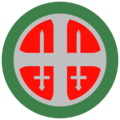 The insignia of the Hirden | |
 Vidkun Quisling and Oliver Møystad inspecting Rikshirden. | |
| Organization overview | |
|---|---|
| Formed | 1940 |
| Dissolved | 1945 |
| Type | Paramilitary |
| Jurisdiction | German-occupied Norway |
| Headquarters | Hirdens hus, Oslo |
| Parent organization | Nasjonal Samling |
Hirden [1] (the hird ) was a uniformed paramilitary organisation during the occupation of Norway by Nazi Germany, modelled the same way as the German Sturmabteilungen. [2]























